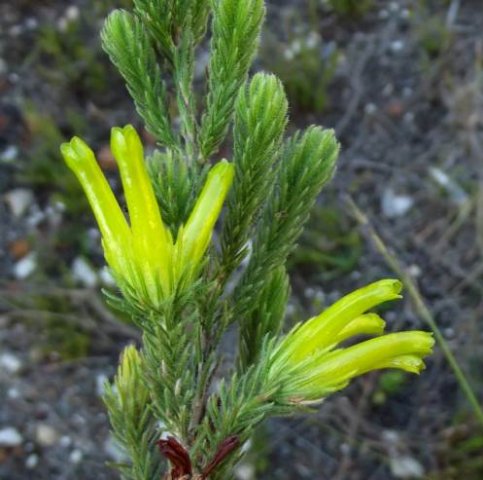Erica unicolor subsp. unicolor

Author: Ivan Lätti
Photographer: Louis Jordaan
Erica unicolor subsp. unicolor, sometimes called the green onecolour heath and previously scientifically E. hirta var. viridiflora and E. viridescens respectively at different stages, is a shrub reaching heights around 1,5 m.
According to the classification of Baker and Oliver the subspecies forms part of the Evanthe section of the Erica genus that bear mostly stem-tip flowers that are tubular and over 9 mm long. Manning and Helme classify the plant among Smooth or Sticky trumpet Heaths that flower on side-shoot tips in aggregated false-spikes or -racemes, mostly hairless and sometimes sticky.
The soft, narrow leaves grow densely or sparsely in whorls, ascending on the stems. The hairy leaves are dark green, their pointed tips may curve in slightly. Leaf length is from 6 mm to 10 mm.
The flowers grow short-stalked or possibly stalkless in small clusters from stem-tips or the tips of short side-branchlets. The calyx is narrow-lobed and leaf-like.
The tubular, sticky flowers are cylindrical, yellow or greenish yellow and shiny, the only unicoloured subspecies of the three. The perianth tip may bulge and curve slightly, its four rounded lobes not curving out. Styles and the eight stamens are included, sometimes manifest or present in the mouth. Flowering happens from late autumn to early spring.
The subspecies distribution is in the southeast of the Western Cape from Riversdale on the coastal mountains to the Eastern Cape as far as Humansdorp. The photo was taken on the Outeniqua Mountains.
The habitat is fynbos growing on lower sandstone slopes and flats. The habitat population is deemed of least concern early in the twenty first century, the only one of the three subspecies to be this fortunate (Manning and Helme, 2024; Bond and Goldblatt, 1984; Baker and Oliver, 1967; iNaturalist; http://redlist.sanbi.org).

